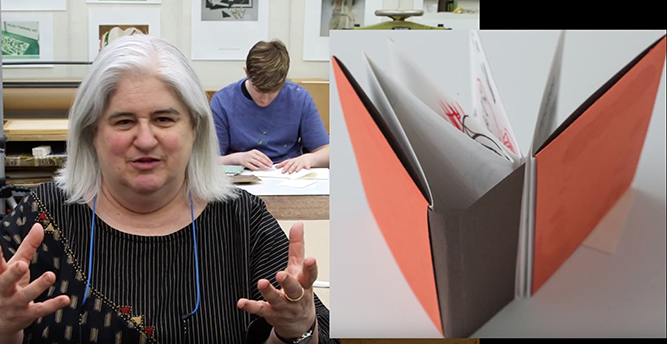Two-Signature Pamphlet demo
This video tutorial demonstrates a nice way to sew two signatures into a cover wrapper. This saves some time as you can quickly sew a printed cover on a two signature book, using the simple three-hole pamphlet stitch.
This video tutorial demonstrates a nice way to sew two signatures into a cover wrapper. This saves some time as you can quickly sew a printed cover on a two signature book, using the simple three-hole pamphlet stitch.
Out Popped Summer was an exhibition at the Kohler Art Library on the University of Wisconsin-Madison campus. The Kohler Art Library has an impressive Artists’ Book Collection with a searchable data base of the objects that are part of the collections. If you have not seen the collection, it is well worth your time to visit the library. Prior to you visit, you might want to research some of the books by using their Artists’Book Collection Database.
Two current MFA students from the Art Department, Carissa Heinrichs and Sarah Stankey provided assistance to Lyn Korenic, Director of the Kohler Art Library with the selection and installation. While the exhibition is over, do watch the video and take advantage of the exhibitions that take place in the entrance of the library.
 This spring, artist Diane Fine gave a two and half hour workshop in my book arts class at UW-Madison. In the workshop students shared in an “exquisite corps” inspired playful drawing exercise. Once the drawings were completed they exchanged their drawings and created an accordion bound book. Diane Fine’s workshop video can be seen from the link.
This spring, artist Diane Fine gave a two and half hour workshop in my book arts class at UW-Madison. In the workshop students shared in an “exquisite corps” inspired playful drawing exercise. Once the drawings were completed they exchanged their drawings and created an accordion bound book. Diane Fine’s workshop video can be seen from the link.
Diane Fine’s 2017 workshop and lecture were made possible by the Leonora G. Berstein Artists’ Book Endowment, at the Kohler Art Library. Many of you are familiar with her books and prints. She publishes books under the name Moonkosh Press. Diane is a 1988 MFA graduate of the Printmaking area at UW-Madiosn. She is also a SUNY Distinguished Teaching Professor at the State University of New York- Plattsburgh.
If you were not able to attend Diane Fine’s lecture, of if you wish to listen to it again, visit the above link to view a video capture of the event. Diane’s was the 3rd Annual Bernstein Book Arts speaker. For more information about her exhibit at the Kohler Art Library and about her visit, please visit the link, Diane Fine Bernstein Book Art Lecture
https://youtu.be/xC6p63xnSj0
I don’t use mythel cellulose paste too often. I like when a paste give a stronger bond. But when you need a paste to make book cloth, methyl cellulose is a one paste to use. I keep methyl cellulose powder in the classroom as you never know when you might need it. When I need paste to make book cloth, I like to have a thicker paste. In this video, I heated water till approximately 150 degrees (70 celsius) and then added 18th of a cup of powder to 1 cup (275 ml) of hot water. I needed a full cup of paste to make the two sheets of book cloth. I did have some left over. It is better to make more than you need. It really does take time to fulling formulate. I would hate to be in a situation where I needed a bit more paste and had to make it on the spot. As it happened another student was working with a faux leather book cover and wanted to try using a mix of PVA and Methyl cellulose (MC). When you mix the two at 50% to 50%, you keep some of the bonding qualities of the PVA but gain some open time to work the book cover. At the end of the video can see that the PVA does not look all that different. It is important to label your jars if you want to be sure you know which jar contains the past or adhesive you want to use. I will be working on a video on how I used the book cloth from this vide.
Book cloth is made in many colors and out of many different materials. But sometimes, you just have to use a fabric for a book cover. The fabric pattern or color might be just what you want to use for the cover. This video will show you how to make book cloth out of fabric. In this video I used some vinyl drafting board cover under the fabric. Many people use glass or plexiglass and some use large sheet of binders board. If you want to make book cloth you should buy enough to experiment. Your fabric might need some adjustment to how this one was made. It might take an extra few steps, but the fabric might make your book exactly what you want it to be.
Students often ask me how they can print a file from a page layout program. It is simply. Once a file has been designed to your liking, export the file to a PDF document. That file can be printed using an inkjet printer with black ink and transparency film. It you want a file that is much higher in resolution, you can contact a service bureau and request the file be printed using a Linotronic Imagesetter. This video outlines the steps that are necessary. Thanks to Elizabeth Jean Younce for her help making the negative. You can watch other videos about making photopolymer plates on my photopolymer playlist on YouTube at this link.
Copyright © 2004–2009. All rights reserved.
RSS Feed. This blog is proudly powered by Wordpress and uses Modern Clix, a theme by Rodrigo Galindez.